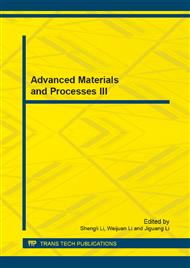p.154
p.158
p.162
p.166
p.170
p.174
p.179
p.187
p.191
Investigation on the Photovoltaic Performance of ZnO Nanoarrays Prepared by Chemical Bath Deposition and Hydrothermal Method
Abstract:
ZnO nanorod arrays were successfully prepared by chemical bath deposition (CBD) and hydrothermal method (HTM), respectively. The photovoltaic performance of ZnO nanoarrays as photoelectrodes in dye-sensitized solar cells (DSCs) was investigated. Experimental results show that ZnO seed crystals prepared by a sol-gol process have c axis orientation and consist of nanoparticles within the range of 50~100nm. The same particle size and orientation is well preserved in ZnO nanoarrays grown on the seed crystal layers. The photovoltaic performance of DSCs based on ZnO nanoarrays as the photoelectrodes is poor, due to the weaker adsorption bond force between ZnO and dye, and lower dye adsorption quantity. By contrast, the DSCs composed of ZnO arrays prepared by hydrothermal method have optimal performance, the corresponding short circuit photocurrent density (Jsc), open circuit voltage (Voc), fill factor (FF) and photoelectric conversion efficiency (η) are 4.89 mA/cm2, 0.650V, 0.39 and 1.25 %, respectively.
Info:
Periodical:
Pages:
170-173
Citation:
Online since:
September 2013
Authors:
Price:
Сopyright:
© 2013 Trans Tech Publications Ltd. All Rights Reserved
Share:
Citation:


